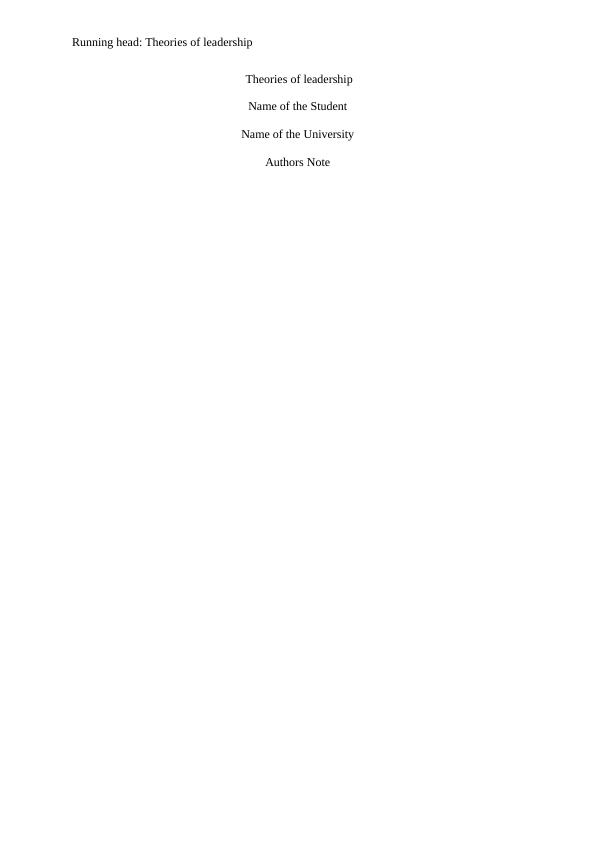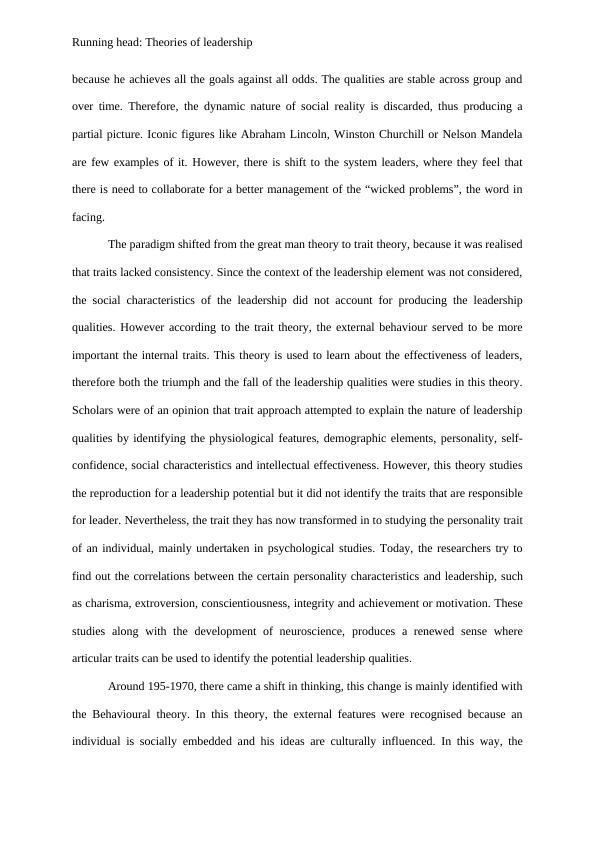Theories of Leadership
Added on 2023-01-18
8 Pages2624 Words49 Views
Running head: Theories of leadership
Theories of leadership
Name of the Student
Name of the University
Authors Note
Theories of leadership
Name of the Student
Name of the University
Authors Note

Running head: Theories of leadership
Theories of leadership – reviewing current research on the evolution and applicability of
leadership theories
Leadership is one of the most complex and multifaceted phenomenon; it refers to the
action of leading a group or an organization. The term leadership existed only since late
1700s and scientific research on this topic leadership began from 20th century (Northouse
2018). Leadership is premised on the basic relationship between two individuals, and it is the
intrinsic nature of human beings to regard each other as different form each other due to this
the feeling of deference arises. As a result, hierarchy is established in relationship between
and among people. Here comes the importance of leader because he has the ability influence
people collectively and lead them to a greater goals. From the time, when leadership theories
emerged, world has been changing in a rapid pace thus it is very important to comprehend the
typology of the different leadership theory and their possible practicality in the present.
According to the Great man theory, leader is considered as a hero. Thomas Carlyle,
who was also the first man who initiated the process of theorizing leadership qualities,
described this theory (Antonakis & Day 2017). According to him, “history of world is but the
biography of great men”, thus s leader is not made but they are born with good qualities. This
view of leadership makes the qualities of the leadership very much rooted in their
individualistic qualities. This paints only a partial picture because, being a leader, he or she
cannot stay out of the human universe. He or she is very much embedded in the social world
and are culturally influenced. The external factors were totally absconded thus it made the
theory impractical. This theory is also informed with patriarchal mind-set because this theory
do not consider the importance of the woman. In this theory the qualities of leadership is
essentially associated with males as the name suggests, great man theory. This theory
underwent a change when the women were emerging as leaders, therefore form the great man
theory to great person theory. In this theory the leader is attributed with the qualities of hero
Theories of leadership – reviewing current research on the evolution and applicability of
leadership theories
Leadership is one of the most complex and multifaceted phenomenon; it refers to the
action of leading a group or an organization. The term leadership existed only since late
1700s and scientific research on this topic leadership began from 20th century (Northouse
2018). Leadership is premised on the basic relationship between two individuals, and it is the
intrinsic nature of human beings to regard each other as different form each other due to this
the feeling of deference arises. As a result, hierarchy is established in relationship between
and among people. Here comes the importance of leader because he has the ability influence
people collectively and lead them to a greater goals. From the time, when leadership theories
emerged, world has been changing in a rapid pace thus it is very important to comprehend the
typology of the different leadership theory and their possible practicality in the present.
According to the Great man theory, leader is considered as a hero. Thomas Carlyle,
who was also the first man who initiated the process of theorizing leadership qualities,
described this theory (Antonakis & Day 2017). According to him, “history of world is but the
biography of great men”, thus s leader is not made but they are born with good qualities. This
view of leadership makes the qualities of the leadership very much rooted in their
individualistic qualities. This paints only a partial picture because, being a leader, he or she
cannot stay out of the human universe. He or she is very much embedded in the social world
and are culturally influenced. The external factors were totally absconded thus it made the
theory impractical. This theory is also informed with patriarchal mind-set because this theory
do not consider the importance of the woman. In this theory the qualities of leadership is
essentially associated with males as the name suggests, great man theory. This theory
underwent a change when the women were emerging as leaders, therefore form the great man
theory to great person theory. In this theory the leader is attributed with the qualities of hero

Running head: Theories of leadership
because he achieves all the goals against all odds. The qualities are stable across group and
over time. Therefore, the dynamic nature of social reality is discarded, thus producing a
partial picture. Iconic figures like Abraham Lincoln, Winston Churchill or Nelson Mandela
are few examples of it. However, there is shift to the system leaders, where they feel that
there is need to collaborate for a better management of the “wicked problems”, the word in
facing.
The paradigm shifted from the great man theory to trait theory, because it was realised
that traits lacked consistency. Since the context of the leadership element was not considered,
the social characteristics of the leadership did not account for producing the leadership
qualities. However according to the trait theory, the external behaviour served to be more
important the internal traits. This theory is used to learn about the effectiveness of leaders,
therefore both the triumph and the fall of the leadership qualities were studies in this theory.
Scholars were of an opinion that trait approach attempted to explain the nature of leadership
qualities by identifying the physiological features, demographic elements, personality, self-
confidence, social characteristics and intellectual effectiveness. However, this theory studies
the reproduction for a leadership potential but it did not identify the traits that are responsible
for leader. Nevertheless, the trait they has now transformed in to studying the personality trait
of an individual, mainly undertaken in psychological studies. Today, the researchers try to
find out the correlations between the certain personality characteristics and leadership, such
as charisma, extroversion, conscientiousness, integrity and achievement or motivation. These
studies along with the development of neuroscience, produces a renewed sense where
articular traits can be used to identify the potential leadership qualities.
Around 195-1970, there came a shift in thinking, this change is mainly identified with
the Behavioural theory. In this theory, the external features were recognised because an
individual is socially embedded and his ideas are culturally influenced. In this way, the
because he achieves all the goals against all odds. The qualities are stable across group and
over time. Therefore, the dynamic nature of social reality is discarded, thus producing a
partial picture. Iconic figures like Abraham Lincoln, Winston Churchill or Nelson Mandela
are few examples of it. However, there is shift to the system leaders, where they feel that
there is need to collaborate for a better management of the “wicked problems”, the word in
facing.
The paradigm shifted from the great man theory to trait theory, because it was realised
that traits lacked consistency. Since the context of the leadership element was not considered,
the social characteristics of the leadership did not account for producing the leadership
qualities. However according to the trait theory, the external behaviour served to be more
important the internal traits. This theory is used to learn about the effectiveness of leaders,
therefore both the triumph and the fall of the leadership qualities were studies in this theory.
Scholars were of an opinion that trait approach attempted to explain the nature of leadership
qualities by identifying the physiological features, demographic elements, personality, self-
confidence, social characteristics and intellectual effectiveness. However, this theory studies
the reproduction for a leadership potential but it did not identify the traits that are responsible
for leader. Nevertheless, the trait they has now transformed in to studying the personality trait
of an individual, mainly undertaken in psychological studies. Today, the researchers try to
find out the correlations between the certain personality characteristics and leadership, such
as charisma, extroversion, conscientiousness, integrity and achievement or motivation. These
studies along with the development of neuroscience, produces a renewed sense where
articular traits can be used to identify the potential leadership qualities.
Around 195-1970, there came a shift in thinking, this change is mainly identified with
the Behavioural theory. In this theory, the external features were recognised because an
individual is socially embedded and his ideas are culturally influenced. In this way, the

End of preview
Want to access all the pages? Upload your documents or become a member.
Related Documents
Leadership Theorieslg...
|5
|1050
|22
Leadership Theorieslg...
|5
|1056
|51
(PDF) Leadership Approaches a Comparative Analysislg...
|11
|2393
|81
Leadership and Management: Factors, Development, and Role in Businesslg...
|14
|3950
|468
A Reflection on Leadership Style for Managerslg...
|12
|3763
|67
Leadership and Governancelg...
|11
|3017
|310